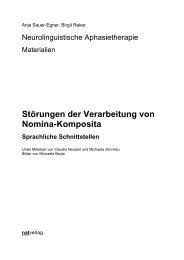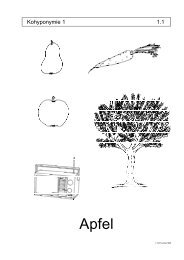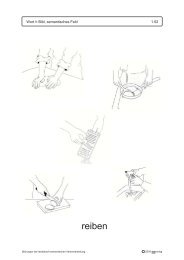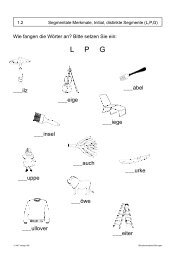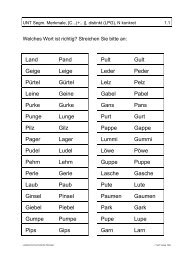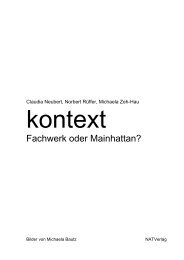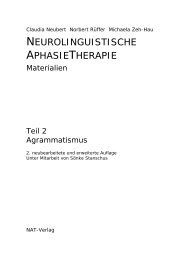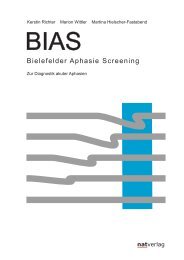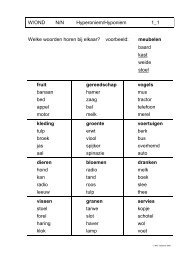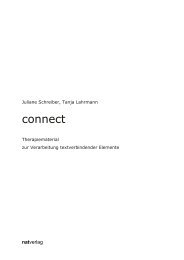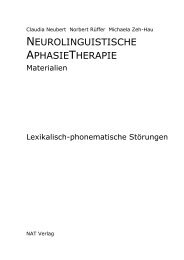Training verb and sentence production in agrammatic Broca's aphasia
Training verb and sentence production in agrammatic Broca's aphasia
Training verb and sentence production in agrammatic Broca's aphasia
Create successful ePaper yourself
Turn your PDF publications into a flip-book with our unique Google optimized e-Paper software.
Downloaded By: [Bastiaanse, Roelien] At: 13:09 17 February 2010<br />
2 LINKS, HURKMANS, BASTIAANSE<br />
proportion of f<strong>in</strong>ite <strong>verb</strong>s <strong>and</strong> <strong>verb</strong> diversity), but not <strong>in</strong> an unrelated variable (diversity<br />
of nouns).<br />
Conclusions: Treatment with ACTION resulted <strong>in</strong> better <strong>production</strong> of f<strong>in</strong>ite <strong>verb</strong>s. The<br />
effects generalised to spontaneous speech. Most importantly, it was shown that communication<br />
<strong>in</strong> daily life improved.<br />
Keywords: Aphasia treatment; Verb therapy; Agrammatic <strong>aphasia</strong>; Broca’s <strong>aphasia</strong>;<br />
Recovery.<br />
Agrammatic Broca’s <strong>aphasia</strong> is characterised by telegraphic speech. Although telegraphic<br />
speech was orig<strong>in</strong>ally described as the use of ma<strong>in</strong>ly content words, <strong>and</strong> content<br />
words were def<strong>in</strong>ed as nouns, <strong>verb</strong>s, <strong>and</strong> adjectives, it is now generally<br />
acknowledged that <strong>agrammatic</strong> speakers have severe problems with <strong>verb</strong> <strong>production</strong>.<br />
They use relatively fewer lexical <strong>verb</strong>s (Saffran, Berndt, & Schwartz, 1989; Thompson,<br />
Shapiro, & Schendel, 1994), <strong>and</strong>/or the diversity of the produced lexical <strong>verb</strong>s is<br />
lower than normal (Bastiaanse & Jonkers, 1998). The <strong>verb</strong>s that are produced are<br />
often un<strong>in</strong>flected. These problems with <strong>verb</strong>s are evident <strong>in</strong> spontaneous speech, <strong>and</strong><br />
<strong>in</strong> nam<strong>in</strong>g <strong>and</strong> <strong>sentence</strong> construction tests (see, e.g., Lee & Thompson, 2004, for<br />
English; Bastiaanse, Hugen, Kos, & Van Zonneveld, 2002, for Dutch). Verb problems<br />
<strong>in</strong> <strong>aphasia</strong> are not just restricted to <strong>in</strong>dividuals with <strong>agrammatic</strong> symptoms; fluent<br />
aphasic speakers are often impaired <strong>in</strong> the <strong>production</strong> of lexical <strong>verb</strong>s as well<br />
(Bastiaanse & Edwards, 2004; Berndt, Mitchum, Haendiges, & S<strong>and</strong>son, 1997;<br />
Jonkers & Bastiaanse, 2007).<br />
Data on the effects of <strong>verb</strong> treatment are relatively scarce. In the 1990s several<br />
studies were done to exam<strong>in</strong>e the effects of mapp<strong>in</strong>g therapy, <strong>in</strong> which the <strong>verb</strong> <strong>and</strong><br />
its argument structure play a central role (e.g., Marshall, 1995; Mitchum & Berndt,<br />
1992; Schwartz, Saffran, F<strong>in</strong>k, Myers, & Mart<strong>in</strong>, 1994). More recently, several <strong>verb</strong><br />
treatment studies have been performed, very nicely reviewed by Conroy, Sage, <strong>and</strong><br />
Lambon Ralph (2006). In some of these studies (Pashek, 1998; Wambaugh, Doyle,<br />
Mart<strong>in</strong>ez, & Kal<strong>in</strong>yak-Flishar, 2002) <strong>verb</strong> retrieval was tra<strong>in</strong>ed <strong>in</strong> a similar way to<br />
noun retrieval; that is, by us<strong>in</strong>g phonological, semantic, <strong>and</strong> gestural cue<strong>in</strong>g. The<br />
researchers found improvement on tra<strong>in</strong>ed items, but no generalisation to untra<strong>in</strong>ed<br />
items. Rodriguez, Raymer, <strong>and</strong> Gonzalez Rothi (2006) <strong>and</strong> Rose <strong>and</strong> Sussmilch<br />
(2008) also described the effects of semantic, semantic-phonologic, <strong>and</strong> gesture (plus<br />
<strong>verb</strong>al) treatments on <strong>verb</strong> <strong>production</strong>. Rodriguez et al. (2006) found no generalisation<br />
to untreated <strong>verb</strong>s, <strong>and</strong> modest generalisation was found <strong>in</strong> the study of Rose<br />
<strong>and</strong> Sussmilch (2008).<br />
The other studies reviewed by Conroy et al. (2006) did not just target <strong>verb</strong> nam<strong>in</strong>g<br />
but also exam<strong>in</strong>ed the effect of therapy on <strong>sentence</strong> <strong>production</strong>. Four of them<br />
focused on aspects of <strong>verb</strong> argument structure <strong>and</strong> <strong>sentence</strong> <strong>production</strong> (F<strong>in</strong>k,<br />
Mart<strong>in</strong>, Schwartz, Saffran, & Myers, 1992; Murray & Karchner, 2000; Schneider &<br />
Thompson, 2003; Webster, Morris, & Frankl<strong>in</strong>, 2005). In several of these studies better<br />
<strong>verb</strong> retrieval after tra<strong>in</strong><strong>in</strong>g was reported. In some participants therapy resulted <strong>in</strong><br />
a better <strong>sentence</strong> <strong>production</strong>, but generalisation to untreated <strong>verb</strong>s was not always<br />
found. Remarkably, generalisation to spontaneous speech <strong>and</strong> to <strong>verb</strong>al communication<br />
<strong>in</strong> daily life has been given little attention. Two studies on “constra<strong>in</strong>t-<strong>in</strong>duced<br />
<strong>aphasia</strong> therapy” focused on communicative <strong>and</strong> behaviourally relevant actions<br />
(Pulvermüller & Berthier, 2008) or <strong>verb</strong> <strong>production</strong> (Goral & Kempler, 2009) were




